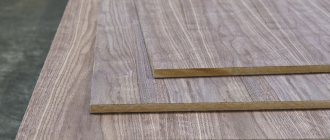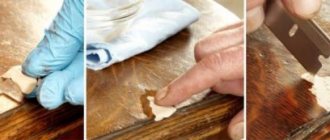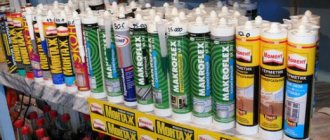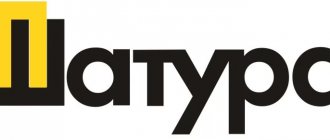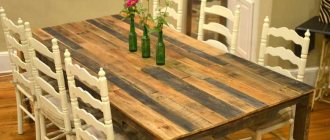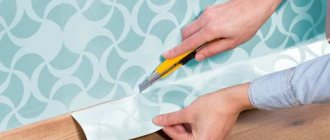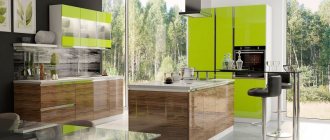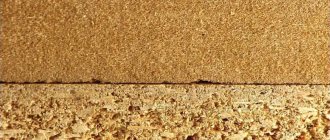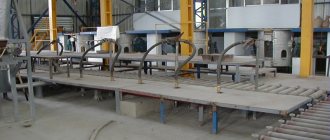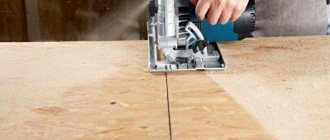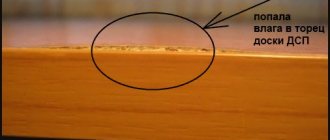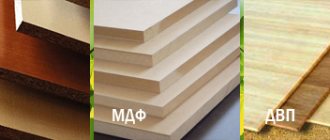Repair and construction
Construction and finishing materials
* The calculations use average data for Russia
General overview of the laminated chipboard production market
Furniture production is perhaps the second most profitable after construction. But currently in Russia the furniture production segment is quite well occupied - a novice entrepreneur will have to make considerable efforts to enter the market.
However, many novice entrepreneurs forget that in some cases it is more profitable to produce raw materials rather than process them and produce finished products. This also applies to furniture production, so the production of materials for making furniture is a more promising occupation than the actual production of furniture.
Laminated chipboard or laminated chipboard is currently the most popular material for furniture. The reason for this is the optimal combination of price and quality. In terms of physical and mechanical properties, including moisture resistance, laminated chipboard is, of course, somewhat inferior to wood, but the variety of textures, ease of processing and low cost are its undoubted advantages.
Indeed: some types of wood - for example, oak or beech - require lengthy and costly processing and preparation, which significantly increases their cost, while laminated chipboard “oak” or “beech” with a similar appearance costs an order of magnitude cheaper.
In addition, opening a business for the production of laminated chipboards is accompanied by such factors as a small number (and in some cities and even regions, the complete absence) of competitors and a vast sales market: after all, even if there are no large furniture factories, all products are simply dismantled by small and medium-sized industries , which have a tendency to gradually enlarge, and therefore increase the demand for laminated chipboard.
All of the above points make the production of laminated chipboard one of the most promising and cost-effective compared to many others.
Chipboard manufacturing technology
Particle boards are incredibly popular, despite their non-functionality and fragile characteristics. What is the secret of popularity? Low price, wide range of applications, variety and large selection. After all, particle boards can be called a bad material for a door or a wall. But what could be better than chipboard for decorating and finishing an old door? How can you visually delimit space if the laws and layout of an apartment or house do not allow you to remove a full-fledged brick wall? Is it easiest to use the material to restore the appearance of a chest of drawers, sideboard or ottoman? The answer to all these questions is one – chipboard.
Chipboard lamination.
Chipboard lamination is the pressing of a cured film onto a chipboard. A layer of glue is applied over the entire surface of the slab and a hard decorative film is pressed onto this layer. The procedure for laminating chipboard slabs takes place under “milder” conditions than during lamination: under a pressure of 5-7 MPa and at a temperature of 120 -150 ̊C. The term "laminated" has German roots and comes from the German Kaschieren, which means "to paste over with paper."
Chipboard laminating line. (photo from the site: izoplit.ru)
Video of the process of laminating some slab material at one of the Chinese factories.
Laminated chipboard panels 10 mm thick.
Laminated chipboard. (photo from the site: woodkeep.ru)
| Interesting information. Some large factories producing serial furniture have their own chipboard laminating workshops to reduce the cost of finished products. Such factories purchase or produce sanded chipboard in small batches, saw it in this form, according to final dimensions, into parts in accordance with the technological map of a particular furniture product. Then a batch of such “raw” parts is sent to the laminating line. From there they get to the workshop, where holes are drilled in the already lined parts on special multi-spindle machines for installing fittings and assembling finished furniture. The method of cladding chipboard - laminating is used as a somewhat technologically simpler and less expensive method. |
Packing chipboards on pallets.
In accordance with the requirements of the standard, the slabs are sorted and then either cut into blanks for furniture panels, or sent to consumers full-size.
Depending on the criteria for the appearance of the slab (cracks, chips, staining, stains, protrusions and depressions), laminated chipboard slabs are divided into the following grades:
- Laminated chipboard - 1st grade
(defects are not acceptable except minimal ones), - Laminated chipboard - 2nd grade
(large surface defects are acceptable), - without grade
(cardinal surface defects).
The production process for making chipboard
The first stage of chipboard production is the grinding of all wood waste using special chipping machines. During grinding, a product called chips is obtained. Chipping machines make all wood waste uniform, of the same consistency, they all become chips. The chips are then delivered to rotary machines, where they are turned into shavings. This scheme is called raw materials - chips - shavings. There is also a slightly different scheme - for example, with logs: log - shavings. There, the logs are placed on special machines with a knife shaft, which immediately cuts the logs into chips.
The production technology of chipboard (chipboard) specifies the exact dimensions that are required for any factory-made chips - its thickness should be 0.5 mm, width - 8 mm, length - from 5 to 40 mm.
It is clear that it is difficult to maintain such parameters with an accuracy of 1 mm even with modern equipment, so small deviations and fluctuations in size are acceptable. Each chipboard manufacturing plant has its own permissible deviation parameters. They are calculated based on the capabilities of specific equipment.
Requirements are also placed on the shape and structure of the chips. It should be absolutely flat (so that it can be easily glued to the plate) and of uniform thickness. Its surface should also be flat and smooth. By the way, the thickness of the chips is measured in special devices, since this is a very important point, especially for those slabs that will be finished with lamination. Raw chips are taken to bunkers, where they are stored until drying. It is delivered to the bunkers using a pneumatic transport system. Then the chips are transferred for drying. Drying chambers dry wood chips to 5% moisture content. The inner layers of chips should have a moisture content of no more than 25%, so chips for different layers are dried in separate drying units. Convective drum dryers burn liquefied gas or fuel oil and have an average temperature of about +10000C.
The shavings for the outer layer are heated and cooled faster. The shavings for the inner layers are heated more slowly, kept in the dryer longer, and cooled gradually. Pneumatic units sort chips for outer and inner layers. Pneumatics distinguishes them precisely by the degree of humidity. Next, the chips are mixed with binders, which are synthetic resins. These resins transform disparate shavings into a single mass. Binding resins are supplied to the chips in the state of liquid solutions.
Next, the tarred chips are sent to the molding units. They pour the tarred shavings onto conveyor belts. Sometimes, instead of conveyors, pallets are used as part of the line, but this is an obsolete part of the lines - there a chip carpet is formed from the shavings. The carpet is divided into bags, which are then hot pressed.
Lamination of wood boards
Lamination (in German Laminieren) means “plate facing”. The type of facing material does not matter for the use of this term. In Russia, lamination is associated with only one of them - paper films impregnated with resins (most often melamine) with incomplete polycondensation. The process of combining the facing film with the base material occurs in short cycle presses (Short cycle press or Kurz–Takt-Press) under the influence of high temperature (up to 2400 C) and pressure (2.0-6.0 MPa). In this case, the film is glued to the base, and the resin with which the paper is impregnated, after final polymerization, gives the surface of the board the properties of a thermosetting plastic, which is highly resistant to mechanical, thermal and chemical influences. According to the current technical conditions, such boards have a long name: “lined with a film based on papers impregnated with thermosetting resins with a low degree of curing,” and in everyday life they are “laminated.”
Lamination presses
Initially, hot multi-bay presses, borrowed from the plywood industry, were used for lamination. The peculiarities of the impregnating resins required that pressing begin with cold plates of the press and gradually heat them up to operating temperature. Therefore, after opening the press, the plates had to be cooled. In addition to the fact that these operations required a significant amount of time, the need to remove the hot coolant and then bring it back to operating temperature led to an increase in energy costs.
In the 80s of the last century, the chemical industry mastered the production of new types of resins, which made it possible for modern enterprises to use short-cycle presses for laminating full-size boards. They are capable of performing 180 or more pressing cycles per hour. This has made lamination a commercially attractive finishing option for wood-based panels. Short-cycle presses are conventional hydraulic installations with heated platens, having basically one bay. Some companies produce double-span presses (Robert Burkle GmbH) with a capacity of up to 360 laminated boards per hour and single-span presses with an increased length (up to 13 m), allowing simultaneous loading of three full-size boards (Henrich Wemhoner GmbH & Co.KG). Their productivity is up to 225 pressing cycles. Some plants use continuous presses from the Hymmer Group. We will mention them a little later.
The hydraulic cylinders of positional short-cycle presses are arranged in two rows along the width of the press. Their number in each row depends on the length of the press and ranges from 6 to 14 pieces.
One of the important parameters of the pressing process that affects the quality of the surface of laminated boards is the uniformity of temperature and pressure distribution over the area of the board. For this purpose, in order to avoid mechanical and thermal deformations, the press plates are quite thick. Inside the stove there are channels for coolant, which is thermal oil. Practice has shown that placing these channels at the center of the cross-section of the heating plate with the coolant flow directed in one direction does not eliminate thermal deformations of the heating plates of the press, which ultimately leads to a decrease in the quality of the coating. Recent developments in this area suggest placing channels as close as possible to the contact surface and using two channel systems for more uniform heating. The second is located closer to the opposite side of the heating plate; the coolant in it is directed in countercurrent to the main system. This solution provides the most uniform distribution of the temperature field of the heating plate and eliminates its deformation. Modern presses from leading manufacturers have precisely balanced parameters of the plate heating system, in particular, the ratio of plate thickness and channel diameter, their shape and location, which ensure temperature balance throughout the entire pressing cycle.
The second important condition for high quality slabs is the uniform distribution of pressure over the slab area. This problem arises especially acutely when it is necessary to veneer slabs of different formats. Siempelkamp proposed increasing the number of cylinders by reducing their size. Siempelkamp presses have four rows of cylinders of 10-14 pcs. in a row. A more uniform distribution of forces applied to the heating plate made it possible to slightly reduce its thickness and, accordingly, energy consumption. The press cylinders are combined into groups, each of which has the ability to be independently controlled. This solution allows you to use a certain number of cylinders for each part format. In addition, autonomous control of the groups ensures optimal pressing conditions. For example, at the beginning of the cycle there is lower pressure at the edges and corners of the slab. Therefore, the press control system slightly increases the pressure in the corresponding groups of cylinders. During the process, the pressure in them is automatically equalized taking into account thermal phenomena in the “heating tape-part” system.
A uniform temperature field and pressure distribution ensures high surface quality even on capricious dark decors. The latter contain as a dye a substance similar to soot or graphite, which impairs the penetrating ability of the resin and somewhat complicates lamination. Therefore, dark decors are impregnated with some margin to compensate for the specified impact of the specified effect. In addition, on darker decors, the smallest defects of the laminated surface become noticeable, which increases the share of the second grade in the production of laminated boards, and hence the cost of the first grade.
Another advantage of increasing the number of cylinders is the reduction in the working height of the press, which reduces capital costs for its installation and labor costs for maintenance.
Modern short-cycle presses are capable of producing products with a relief surface. Embossing, imitation of the texture of wood or other materials on the surface of a part is achieved using special press pads, which are attached to the press plates through a special heat-conducting damper material. For this purpose, special pallets and devices for their quick change are used. Domestic enterprises (for example, Kronastar) often use two types of stamping - PR or SE. Both imitate wood grain, PR is an embossing consisting of longer, but rarer strokes, making it visible even in low light. The SE structure is an embossing of short and frequent strokes, which is pleasant to the touch and well imitates the surface of wood. There are other types “under tiles”, “under piece parquet”, etc.
Continuous presses from the Hymmer Group represent a new step in the lamination of wood-based panels. The design of such a press includes two endless steel belts on drums with devices that provide the necessary pressure and heating of these belts. The company produces two types of similar presses. The first is isobaric (“soft”) presses, which promote uniform and constant pressure distribution over the entire area of the slab. They are used for laminating wood boards (chipboard and MDF). Isochronous (“rigid”) continuous presses are designed for cladding sandwich panels, cork panels, etc.
The continuous press is equipped with several devices for feeding film, which is in rolls, for quickly changing the decor. The slabs are fed into the press with virtually no gap, so the losses at the transverse edges are negligible. Hymmer Group presses are equipped with a special device for changing belts. The resource of the tape produced by Berndorf Band is over 7 million m2 of laminated board. With the same productivity as short-cycle presses, continuous presses consume one third less electricity.
Lamination lines
The presses discussed above are used as part of automated lamination lines, which differ in productivity and degree of automation, but contain almost the same equipment.
The lamination line for small volumes produced by Robert Burkle GmbH includes a device for laying the board on a conveyor with a device for cleaning the surface of the boards, and a bag assembly system (laying pre-cut film to size). On some lines, package assembly is done manually. The film is held on the surface of the plate electrostatically. For high-performance lines, pouch assembly is fully automated and includes a special system for precise positioning of film and plate in the press. Such a system is necessary when producing embossed boards. Before the press, a video camera system records the reference marks printed on the decorative paper, determining the exact position of the paper. Based on the found main deviation, the general correction vector of the entire package is determined. Once these vectors are registered in the system, it becomes possible to align all subsequent packages to the press pad. For this purpose, for example, Siempelkamp specialists have developed a conveyor belt that is movable in the longitudinal and transverse directions. Thus, with an accuracy of 0.2-0.5 mm, it is possible to achieve a coincidence of the structure specified by the press pad with the synchronizing pores of the decorative pattern of the papers. The aligned package is placed into the press from the loading side in the correct position and exits from the unloading side of the press. Special servomotors and a toothed belt drive ensure fast, precise and repeatable positioning.
Next comes the loading system, the press itself and the press unloading system, a system for monitoring, cleaning and removing overhangs and a device for cooling and stacking the finished slabs.
The press loading and unloading systems operate synchronously, i.e. simultaneously with the loading of a new package, the finished slab leaves the press. To change press pads (including those for embossed surfaces), a special device is placed next to the press.
Impregnating resins already contain a release agent, so there is no need to apply it to the surface of the press pads. However, they need to be cleaned periodically. There are different cleaning methods used, but they should be written about separately and in more detail.
Continuous presses are equipped with devices for feeding film from rolls and devices for unwinding (at the input) and winding (at the output) the tape (analogous to a press pad) to obtain an embossed surface. The change of decors and type of embossing is fully automated (Hymmer Group line). These devices are quite simply and accurately synchronized by the line control system in order to ensure that the structure specified by a special tape (analogous to a press pad) matches the synchronizing pores of the decorative pattern of the papers.
In Russia, the most widespread lamination lines are from Henrich Wemhoner GmbH & Co.KG, Robert Burkle GmbH, Hymmer (short-cycle presses), Siempelkamp and Diffenbacher groups (Germany), Javor-Stroji (Slovenia). Equipment for the production of laminated boards and laminated floor coverings is also produced by Longoni Roberto and Pagnoni Impianti (Italy), Biele SA (Spain). Press gaskets for short-cycle presses from Berndorf Band (Austria) have proven themselves well.
Almost all line manufacturers create them according to the customer’s technical specifications, taking into account his conditions and production volumes.
In the following publications it is planned to consider equipment for impregnation of films, the requirements for facing materials and the base plate, and also touch upon practical issues of operating lamination lines.
Sergey Afanasyev
Source of information: magazine “Derevo.RU” No. 1 (34) January-February 2006 https://www.derewo.ru/
Manufacturing of particle boards (chipboards)
After pressing, the packages of chips become very dense, hard, and can be transported. By the way, it is only in recent years that chipboards are made exclusively from chips, which are glued with resins and pressed with a hot press, after which the finished board is obtained. Previously, when there were no such powerful hot presses and synthetic resins, the chips were glued together with a special glue, they waited a long time for them to harden, and the barely holding chip structure was glued onto a thin wooden slab.
The production technology of chipboard (chipboard) has changed over time, becoming more and more improved. Now, after pressing, the slabs are delivered to the unloading line, where they are cut to the required size, then they are cooled, then ground and coated with special fixatives and resins. After this, they are packaged in packaging from the manufacturer and delivered to stores. Previously, chipboard (chipboard) production technology involved manual cutting and manual packaging of finished products.
Video of the technological process of an automatic line for the production of chipboards:
Other similar articles on Chipboard manufacturing technology
Chipboard lamination.
Chipboard lamination is the process of covering board surfaces with paper-resin films impregnated with resins. The combined effect of pressure (25-28 MPa) and high temperature (140-210 ̊ C) causes the film to practically “grow” into the surface of the chipboard. The word “lamination” itself is of English origin and is translated as “layering, rolling, layering.”
Chipboard lamination line, made in China. (photo from website: china1.ru)
Fast lamination line. (photo: elo.ru)
Components of the line:
| Feeding the slab into the press. | Multi-vacuum device with reversible strip for film laying. |
Laminated chipboard.
Labeling, transportation and storage
A label is attached to each pack of laminated MDF boards indicating:
- name of the manufacturer;
- address of the manufacturer;
- name of the country of origin;
- Name of product;
- designation of technical conditions;
- area of application of plates;
- transportation rules;
- storage and use;
- brand of slabs;
- slab sizes;
- emission class;
- number of MDF boards in packs, pieces and m2;
- date of manufacture;
- change;
- technical control stamp.
Laminated MDF boards can be transported by any vehicles or wagons, subject to compliance with the rules for transporting goods.
During transportation, laminated MDF boards should be protected from wind, rain, snow and mechanical damage.
Laminated boards are stored indoors, at a relative humidity of no more than 70% and a temperature not higher than 25 0 C.
